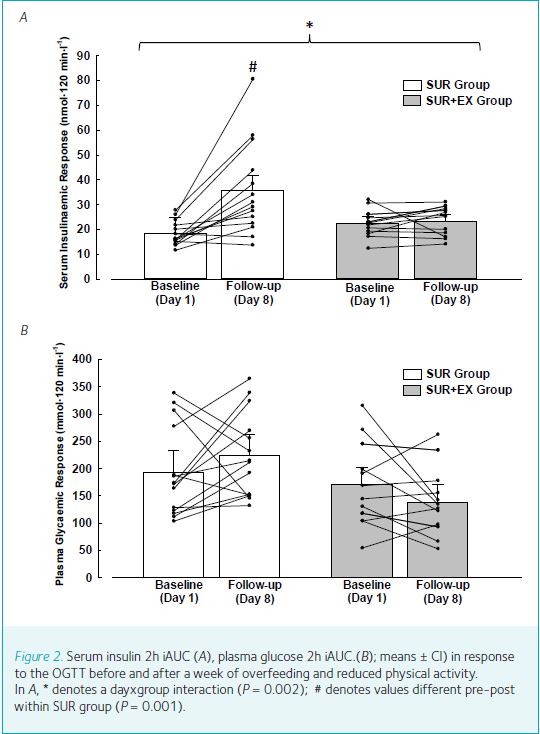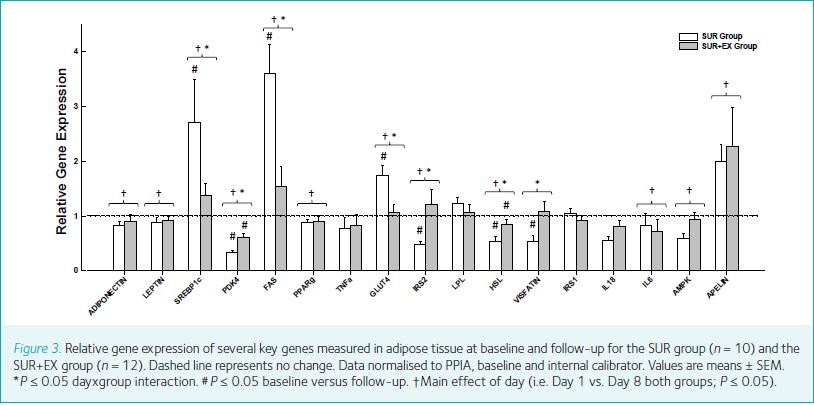
Physiology News Magazine
Exercise: more than just a role in energy balance
Improving our understanding of the mechanisms by which physical exercise enhances health requires physiologists to isolate the relative effects of exercise per se.
Features
Exercise: more than just a role in energy balance
Improving our understanding of the mechanisms by which physical exercise enhances health requires physiologists to isolate the relative effects of exercise per se.
Features
Jean-Philippe Walhin, James Betts & Dylan Thompson
Department for Health University of Bath, UK
https://doi.org/10.36866/pn.97.25
Research studies investigating the impact of exercise on health often show physical activity/exercise to be beneficial. However, energy status (deficit, balance, surplus) can have a profound impact on metabolism. To understand whether exercise leads to health improvements, energy balance needs to be carefully controlled.
Numerous studies have shown that regular exercise can have beneficial effects on metabolic function and various other health markers. Over the last decade, there has been a prolonged debate about whether the effects of exercise are simply secondary to the role of exercise in energy balance. Whether exercise offers additional benefits compared to diet alone remains unclear – which makes it difficult to provide clear guidance to the public and healthcare professionals. If exercise is only important because of a role in energy balance then, arguably, the greatest emphasis and focus should be on adiposity as the key outcome – irrespective of the route via which weight loss or weight maintenance has been achieved (i.e. diet or exercise). In this context, one historical problem is that many exercise studies fail to adequately control energy balance in order to unpick the relative effects of exercise per se. For example, if a group of individuals are trained for several weeks during which they lose several kilograms of adipose, it will remain unclear which physiological events were primary in driving any observed changes (i.e. exercise, energy balance or loss of adipose). To understand and isolate how exercise exerts its effects on metabolism, it is important to conduct studies that will tease apart the effects of energy balance and weight loss from exercise/physical activity, while carefully controlling energy status (Braun & Brooks, 2008).
Some excellent studies have already started to unpick the relative importance of exercise in the context of an energy deficit. For example, work by the CALERIE team at Pennington has used sophisticated designs where weight reduction was achieved either through caloric restriction alone, or through a combination of caloric restriction and increased structured exercise. The energy deficit elicited was matched between groups leading to similar changes in body mass and composition (Redman et al. 2009). While this study suggested that exercise plays an equivalent role to caloric restriction in terms of energy balance, another study by the same group showed that exercise combined with caloric restriction did further improve metabolic function compared to caloric restriction alone (Larson-Meyer et al. 2010). Although understanding the contribution of physical exercise during a period of energy deficit or energy balance is extremely helpful in the context of weight loss, it is only part of the picture. It is likely that most individuals intermittently experience brief periods of positive energy balance and experimental studies focusing on the impact of exercise and physical activity during periods of energy surplus might be equally relevant.

One of our recent papers published in The Journal of Physiology took a very different approach with striking results (Walhin et al. 2013). In this study, 26 healthy young men reduced their physical activity to sedentary levels (≤ 4000 steps per day) for 7 days. Half of the group performed a daily bout of vigorous-intensity treadmill running for 45 minutes. Everyone was asked to over-consume their habitual diet: the non-exercising group (SUR group) increased their energy intake by 50%, whilst the exercising group (SUR+EX group) increased their energy intake by 50% plus the energy expended during the exercise (so the net energy surplus was matched in both groups). After one week and a surplus of around 17,000 kilocalories, serum insulin responses to glucose ingestion and biopsies of adipose tissue were taken. Results showed that participants from both groups gained weight during the course of the intervention. Fig. 1 shows the matched energy surplus induced in both groups.

The combination of short-term overfeeding and reduced physical activity had a dramatic impact on insulin sensitivity (Fig. 2). We demonstrated that after just 7 days of positive energy balance, fasting insulin concentrations increased and the ingestion of 75 g of glucose resulted in a ~2-fold increase in the insulinaemic response of healthy individuals. Our calculations suggest that excess carbohydrates would have resulted in a saturation of skeletal muscle and liver glycogen stores. It is likely this contributed to a decrease in insulin sensitivity. Remarkably, the inclusion of a daily vigorous-intensity exercise bout largely prevented these changes from taking place even though extra food was provided to the participants in order to keep the energy surplus the same between groups. Thus, even though the SUR+EX group consumed even more energy in order to match the energy surplus of the SUR group, they were still better off at the end of the week.

Surprisingly few studies have focused on changes in the expression patterns of key genes in adipose tissue during a bout of energy surplus in healthy individuals, considering it is the major site for energy storage. The experimental model used in this study had a significant impact on the expression of several key genes within adipose tissue (Fig. 3). For example, overfeeding and reduced activity significantly increased the expression of both SREBP-1c and FAS transcripts in the SUR group. SREBP-1c is a transcription factor that regulates the expression of the lipogenic enzymes FAS. It is likely that the protocol used would have rapidly saturated liver and muscle glycogen stores favouring a lipogenic environment. The SUR group had little capacity for carbohydrate oxidation as a result of restricted physical activity. SREBP-1c has been linked with de novo lipogenesis (DNL) which has been shown to take place in adipose tissue, thus providing a route for the disposal of excess glucose. Other genes and proteins such as PDK4, HSL, IRS2 and AMPK were down-regulated, highlighting a switch of oxidative fuel from fatty acids to glucose. It is possible that these changes within adipose tissue may be a secondary response to the marked hyperinsulinaemia resulting from the positive energy balance induced by the overfeeding and reduced physical activity – although as we discuss in the full paper there are a number of other possibilities. It is particularly interesting that exercise exerted pronounced effects in adipose tissue, even whilst it was expanding (i.e. whilst people were gaining weight).
This study provides some of the strongest evidence to date that the picture is far more sophisticated than simply understanding the contribution of exercise towards energy balance alone. Exercise has positive effects even when we are actively storing energy and gaining weight. Interestingly, exercise has a powerful impact in adipose even when energy is being actively stored within this specific tissue. This is rather reassuring because even a large amount of exercise plays only a relatively modest role in overall energy balance (Turner et al. 2010). The fact that this nonetheless exerts powerful physiological effects supports a justifiable focus on exercise (independent of its role in energy balance and the regulation of adiposity).
While the model used here might seem extreme to many readers, it is strikingly similar to what many of us experience at particular times of the year (Hull et al. 2006). Incidentally, the journal article was published towards the end of last year around Thanksgiving and Christmas which created enormous media interest. Newspapers such as The New York Times, The Telegraph and Le Monde picked up on the findings and the article in The New York Times was one of the most read stories on their website for a few days. Maybe the fact most people can relate to these findings is part of the reason this study created such interest. This was reflected in some of the headlines: ‘Daily exercise can help ensure guilt-free Christmas’, ‘Workout “cuts festive food damage”, ‘Exercise allows “healthy overeating” during holidays: daily workouts offset metabolic disruption, nutritional imbalance’. Of course, further work is required to establish whether these findings would be valid in the longer term and whether other forms of exercise varying in intensity and duration would provide the same benefits.
In summary, the experimental model that we used in our paper in The Journal of Physiology successfully enabled us to tease apart the relative importance of exercise independent of energy balance. These results demonstrate that exercise has powerful effects on physiological function even in the face of a considerable energy surplus and whilst people are actively gaining weight. This study adds to the evidence that we should not just be looking at exercise as a route to achieve energy balance and weight loss, but also because it can have profound physiological effects. The emphasis should not just focus on body mass alone, but also on the behaviour (exercise).
References
Braun B & Brooks GA (2008). Critical importance of controlling energy status to understand the effects of ‘exercise’ on metabolism. Exerc Sport Sci Rev 36, 2–4.
Hull HR, Radley D, Dinger MK & Fields DA (2006). The effect of the Thanksgiving holiday on weight gain. Nutr J 5, 29.
Larson-Meyer DE, Redman L, Heilbronn LK, Martin CK & Ravussin E (2010). Caloric restriction with or without exercise: the fitness versus fatness debate. Med Sci Sports Exerc 42, 152–159.
Turner JE, Markovitch D, Betts JA & Thompson D (2010). Nonprescribed physical activity energy expenditure is maintained with structured exercise and implicates a compensatory increase in energy intake. Am J Clin Nutr 92, 1009–1016.
Redman LM, Heilbronn LK, Martin CK, de Jonge L, Williamson DA, Delany JP & Ravussin E (2009). Metabolic and behavioral compensations in response to caloric restriction: implications for the maintenance of weight loss. PLoS One 4, e4377.
Walhin JP, Richardson JD, Betts JA & Thompson D(2013). Exercise counteracts the effects of short-term overfeeding and reduced physical activity independent of energy imbalance in healthy young men. J Physiol 591, 6231–6243.
